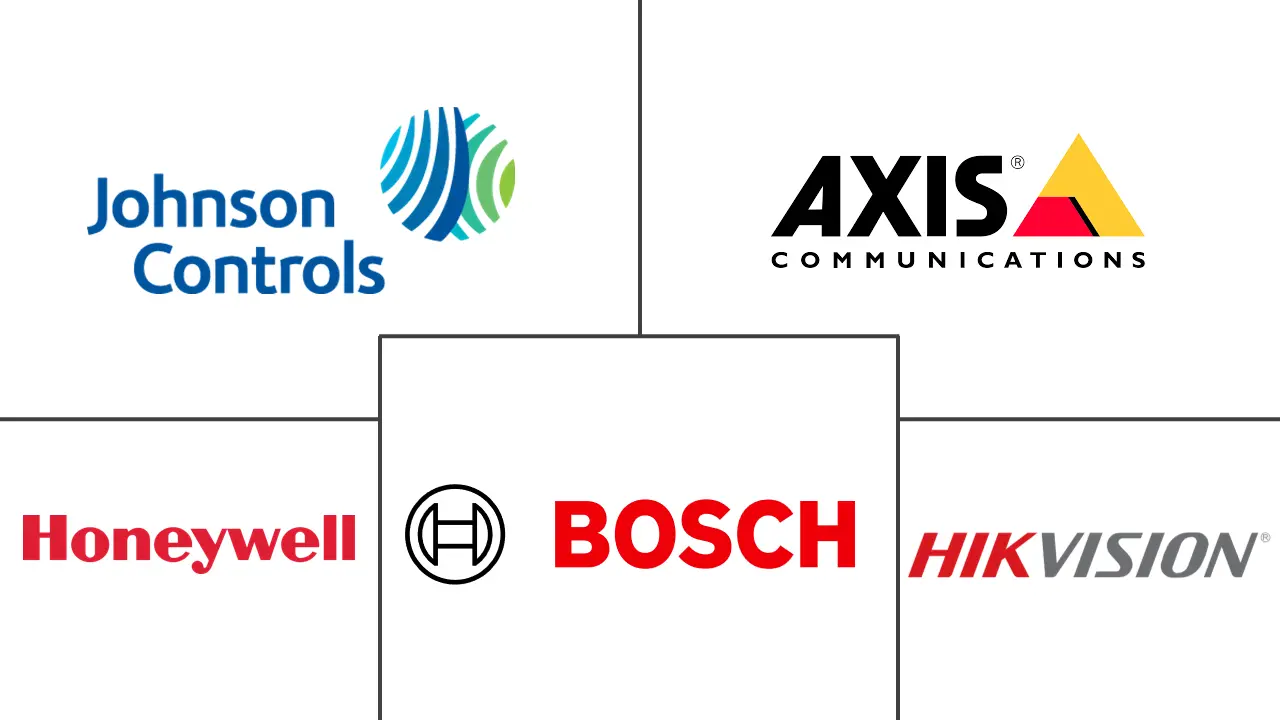Asia Pacific Access Control Software Market Size and Share
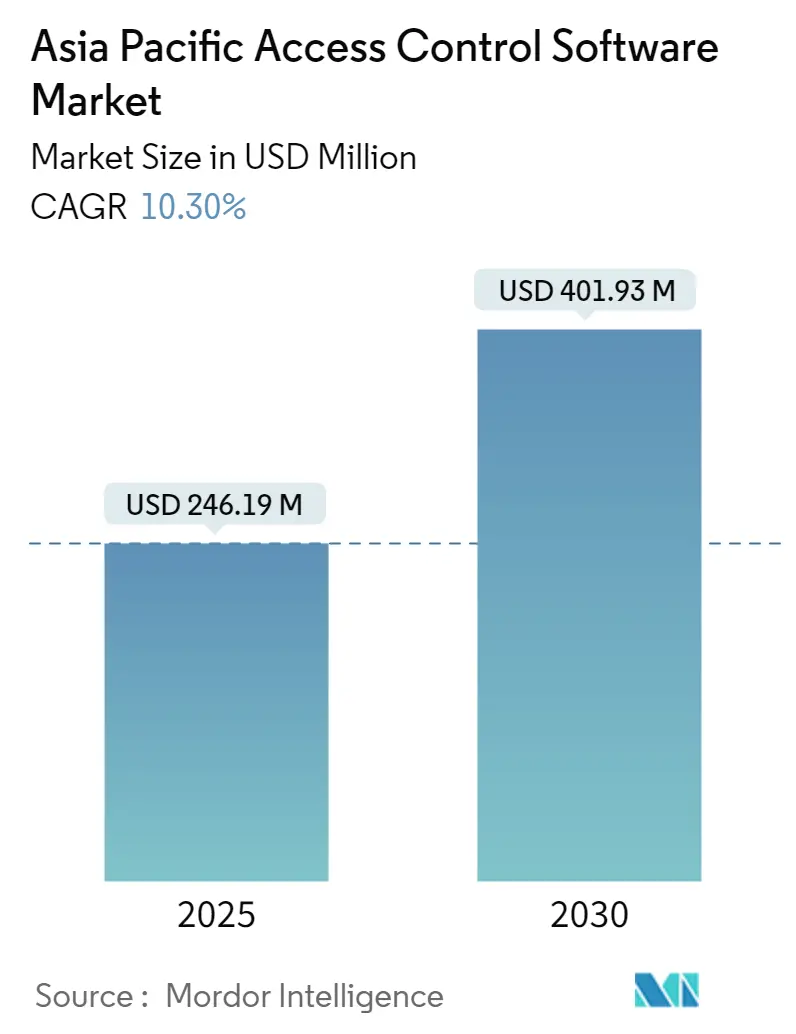
Asia Pacific Access Control Software Market Analysis by Mordor Intelligence
The Asia Pacific Access Control Software Market size is estimated at USD 246.19 million in 2025, and is expected to reach USD 401.93 million by 2030, at a CAGR of 10.3% during the forecast period (2025-2030).
In the last few decades, the commercial and industrial sectors of Asia-Pacific witnessed remarkable growth. Countries like China, India, and Taiwan, among others, opening the market for global firms, have significantly driven investments in the region as businesses continue to flock to the market to leverage the availability of low-cost workforce and the presence of a large consumer market. As a result, the number of commercial and industrial establishments in the region has grown significantly, creating opportunities in the market studied.
Increased digitization across Asia-Pacific and a desire for improvement in business processes have increased the adoption of various digital technologies, leading to a significant spike in the amount of data generated. As some of the data related to business operations are highly critical for businesses, there is a need to ensure optimum security of the data, which is driving the attention of companies toward advanced solutions, such as access control software, as it ensures the right person has access to right place both in the office and the IT system.
In Asia-Pacific, countries like India, China, and the Philippines have witnessed notable growth in IT-related businesses. For instance, India emerged as a significant software outsourcing hub. According to NASSCOM, in FY 2023, the revenue of the technology industry (including hardware) in India was estimated to cross the evaluation of about USD 245 billion, reporting an 8.4% Y-o-Y growth. Such trends are anticipated to drive the demand for access control solutions in offices belonging to IT firms and other related enterprises.
Furthermore, the market share of access control solutions is also anticipated to witness notable growth in the residential sector of the region as the instances of house breaches, theft, and trespassing remain significant across various countries. The growing proliferation of smart home devices is also making consumers more accepting of advanced home security solutions, creating a favorable outlook for the market studied.
However, in Asia-Pacific, the concentration of small and medium enterprises is relatively higher in developed regions. As a result, the price sensitivity of the consumers in the commercial segment is high. Low economic growth across several countries also restraints the adoption of access control software solutions in the residential segment. Furthermore, a lower awareness about the risk of cyberattacks and a lack of regulations related to cybersecurity issues also challenge the market's growth in the region.
Asia-Pacific was significantly impacted by the pandemic. As a result, widespread lockdowns were imposed across major countries, leading to businesses closing their offices and shifting to a remote working model, which slowed down the growth of the market in the region. However, a major positive influence of the pandemic was the growth in awareness about digital technologies. The pandemic significantly enhanced the exposure to intelligent technologies, which may drive the growth of the market studied during the forecast period.
Asia Pacific Access Control Software Market Trends and Insights
Commercial to Hold Significant Market Share
- The commercial sector is anticipated to remain among the prominent adopters of access control software solutions in the Asia Pacific. The solutions enable businesses and commercial facility operators to efficiently secure the premises by allowing access to critical locations or infrastructure only to authorized employees.
- Considering a higher population concentration, the region's public transportation sector is investing significantly in developing systems that can help authorities efficiently manage traffic across various transportation terminals, creating a favorable outlook for the market's growth in the region. For instance, the airlines and airports in China are working globally to automate the passenger journey, with 100% of airlines investing in upgrading their passenger management systems. According to SITA’s Air Transport Insights, airports are investing ambitiously in the biometric-powered journey, with about 86% planning to have self-boarding gates with the deployment of biometrics only by 2024 and 58% planning to adopt a secure single biometric token across all touchpoints.
- A similar trend has been observed across other commercial establishments. For instance, in 2023, Alibaba was planning to provide facial recognition for biometric check-ins for in-country travelers at two Marriott International hotels in China, as per reports from the hotel management industry. According to Marriott, traditional hotel check-ins take three minutes, even without a line. Thus, with the deployment, the self-check-in procedure, consisting of an ID document scan, personal information entry, and face recognition verification, can be completed in significantly less time.
- Furthermore, the region is also witnessing a notable growth in investment to develop commercial establishments. For instance, according to the Ministry of Land, Infrastructure, Transport and Tourism, in 2023, the estimated cost of office building construction starts in Japan stood at JPY 2.36 trillion (~USD 17.7 billion), compared to JPY 1.89 trillion (~USD 11.77 billion) in 2018.
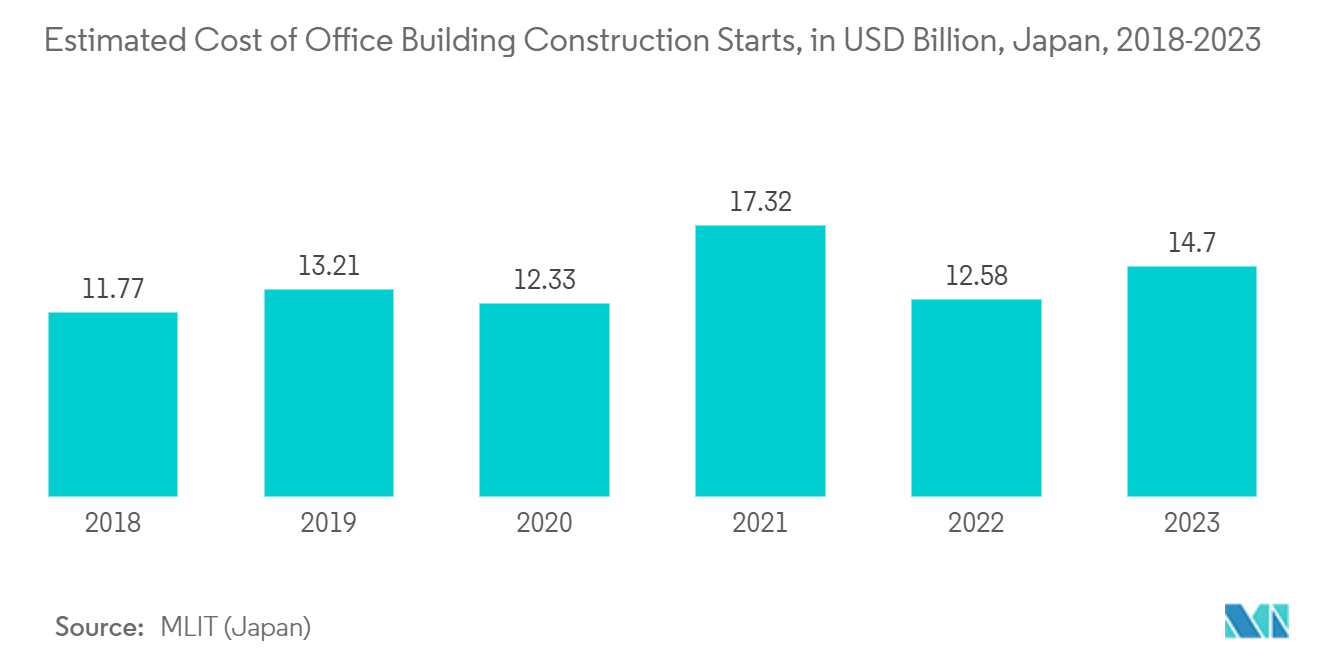
India to Witness Significant Growth
- The growing industrialization leads to a high demand for securing assets and data. Urbanization in the region is driving the need for access controls in residential and commercial areas owing to security concerns. The increasing number of IT offices in Indian cities, such as Hyderabad, Delhi, Chennai, Bangalore, and Mumbai, is increasing the adoption of technologically advanced, contactless access control systems for various applications.
- Due to the rapidly growing security concerns, India is witnessing increased adoption of access control systems and solutions in various sectors, including corporate offices, hotels, government institutions, and residential buildings. Several key players are developing devices per the Indian smart home requirements under the Government of India programs, such as Digital India and Make in India.
- The rising crime rates and the introduction of technologically sophisticated and contactless smart cards for various applications will create new opportunities for market participants over the coming years. Increasing mobile payment transactions, coupled with growing government and private corporation initiatives toward adopting biometric authentication software, are expected to drive the growth of the market in the country.
- The increasing number of IT companies in the country may provide significant opportunities for the market. For instance, according to the Ministry of Corporate Affairs, in 2023, India had about 1.62 million active companies. Organizations are increasingly investing in solutions to regulate access to buildings and digital platforms to track employee and customer attendance. Hence, the growing number of companies in the country will favor the growth of the market studied.
- Furthermore, in India, trends like digitization and intelligent cities have significantly enhanced the demand for smart home solutions, which are anticipated to impact the market's growth positively. For instance, according to the Ministry of Finance (India) and the Ministry of Housing and Urban Affairs (MoHUA), in FY 2023, expenditure on India's smart city mission stood at INR 68 billion (~USD 0.81 billion).
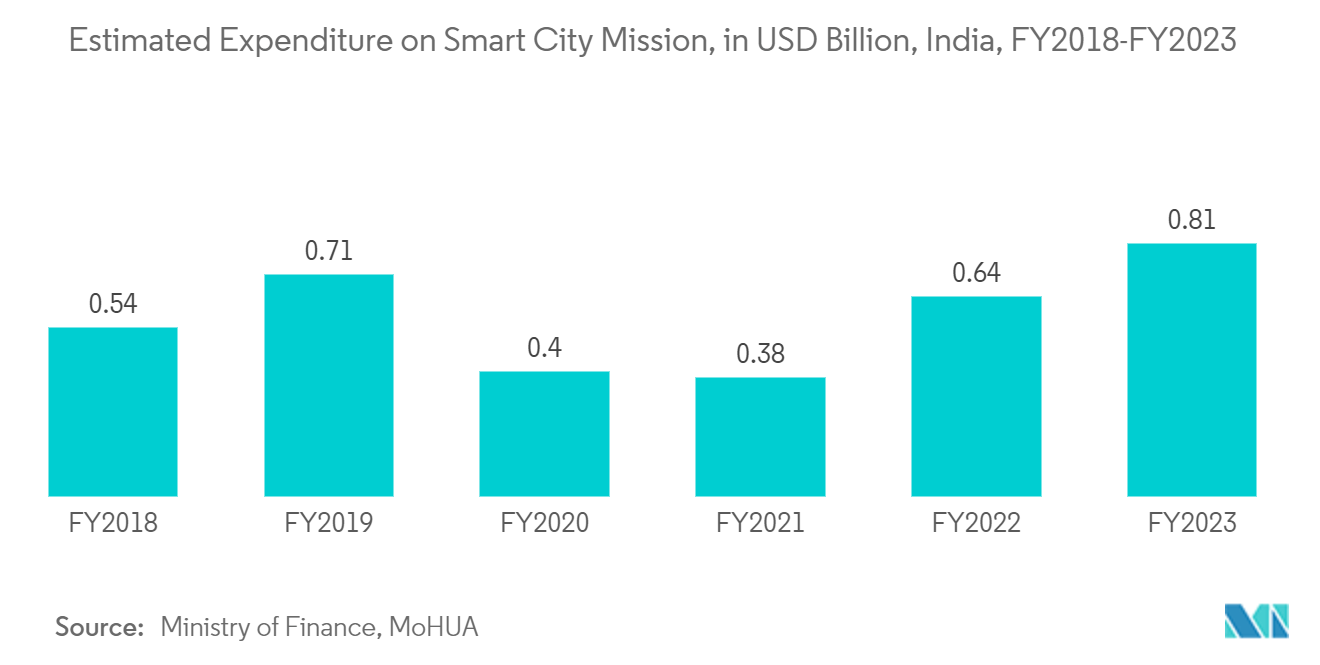
Competitive Landscape
The Asia-Pacific access control software market is highly competitive and has several players. Companies in the market continuously try to increase their market presence by introducing new products, expanding operations, or entering into strategic mergers and acquisitions, partnerships, and collaborations. Some of the major players include Bosch Security and Safety Systems, Johnson Controls, and Hikvision.
- In March 2024, Verkada, a cloud-based physical security solutions provider, opened its new ASEAN headquarters in Singapore. Through this, the company aims to enhance its ability to support its growing regional customer base. The company's suite of products encompasses a wide range of solutions, including access control systems, video security cameras, environmental sensors, intercoms, and workplace management tools.
- In February 2024, Hikvision unveiled its second-generation professional access control products, marking a significant advancement in access management. The company's latest offerings boast enhanced features, such as versatile authentication methods, web-based management, specialized access applications, and integrated security solutions.
Asia Pacific Access Control Software Industry Leaders
-
Bosch Security and Safety Systems
-
Axis Communications AB
-
Johnson Controls
-
Hangzhou Hikvision Digital Technology Co., Ltd.
-
Honeywell International Inc.
- *Disclaimer: Major Players sorted in no particular order
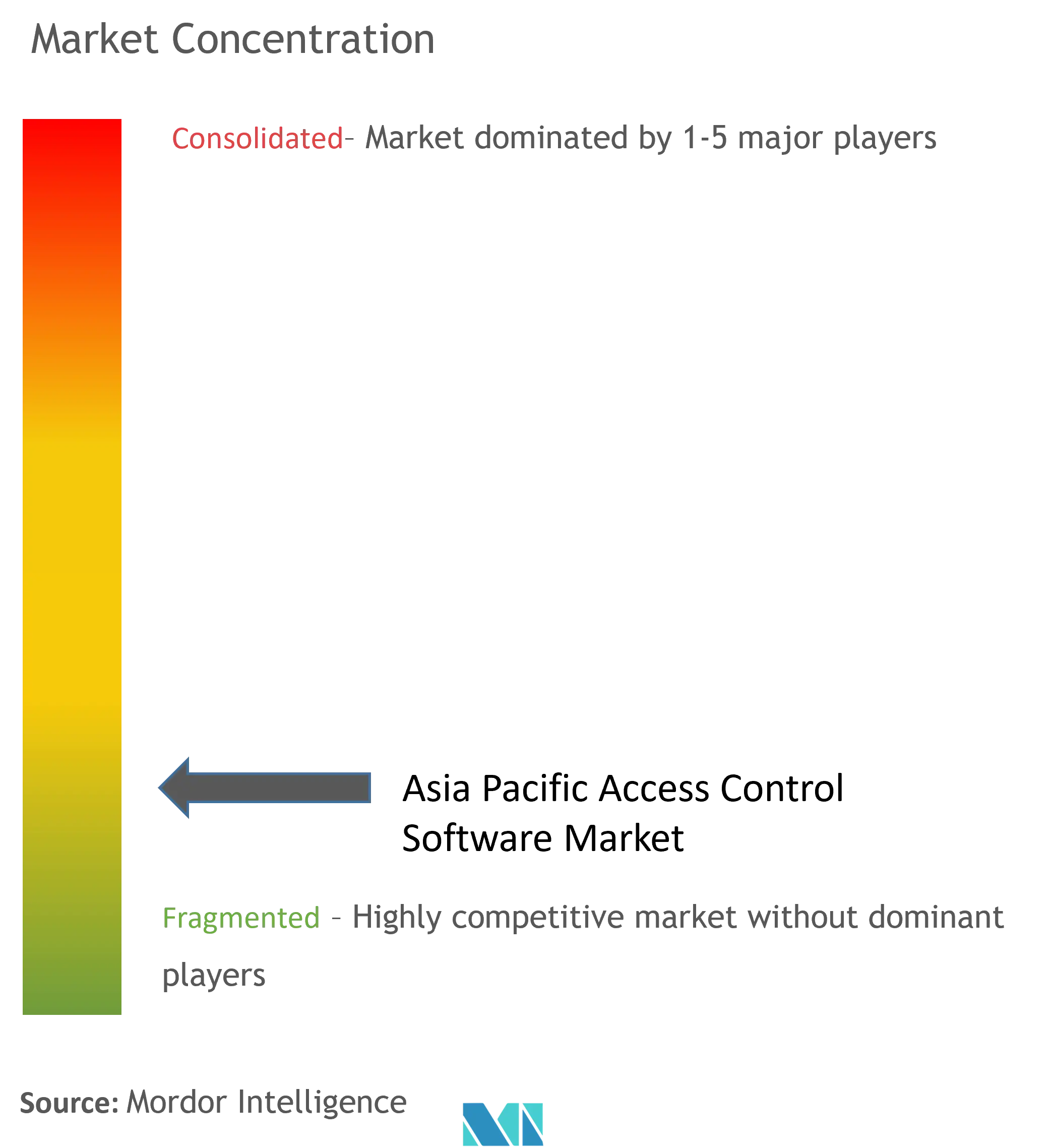
Recent Industry Developments
- January 2024: Keeper Security APAC KK, a cybersecurity software provider for protective privileged access, passkeys, passwords, secrets, and connections, announced Yayoi Co. Ltd will be a referral partner for its solutions, making the company accountable for software development distribution and support service in Japan.
- September 2023: Aiphone launched access control management software, AC Nio. The software is easy to use and has a customizable dashboard that provides the tools to manage daily access control credentials, set schedules, and run reports.
Asia Pacific Access Control Software Market Report Scope
Access control software is an essential element of security that governs who is allowed access to specific information, applications, and data sources. It allows organizations to control access to gates, doors, and other areas wherein authorization is required, ensuring that only authorized personnel are permitted in secure locations. It also helps safeguard sensitive information, such as information of customers and intellectual property, from being stolen by malicious actors or unauthorized users.
The Asia-Pacific access control software market is segmented by type (on-premise and cloud-based), organization size (SMEs and large enterprises), end-user industry (commercial, residential, government, industrial, transportation and logistics, military and defense, and other end-user industries), and country (India, China, Japan, and Rest of Asia-Pacific). The market sizes and forecasts are provided in terms of value (USD) for all the above segments.
| On-premise |
| Cloud-based |
| SMEs |
| Large Enterprises |
| Commercial |
| Residential |
| Government |
| Industrial |
| Transportation and Logistics |
| Military and Defense |
| Other End-user Industries |
| India |
| China |
| Japan |
| South Korea |
| Australia |
| New Zealand |
| By Type | On-premise |
| Cloud-based | |
| By Organization Size | SMEs |
| Large Enterprises | |
| By End-user Industry | Commercial |
| Residential | |
| Government | |
| Industrial | |
| Transportation and Logistics | |
| Military and Defense | |
| Other End-user Industries | |
| By Country*** | India |
| China | |
| Japan | |
| South Korea | |
| Australia | |
| New Zealand |
Key Questions Answered in the Report
How big is the Asia Pacific Access Control Software Market?
The Asia Pacific Access Control Software Market size is expected to reach USD 246.19 million in 2025 and grow at a CAGR of 10.30% to reach USD 401.93 million by 2030.
What is the current Asia Pacific Access Control Software Market size?
In 2025, the Asia Pacific Access Control Software Market size is expected to reach USD 246.19 million.
Who are the key players in Asia Pacific Access Control Software Market?
Bosch Security and Safety Systems, Axis Communications AB, Johnson Controls, Hangzhou Hikvision Digital Technology Co., Ltd. and Honeywell International Inc. are the major companies operating in the Asia Pacific Access Control Software Market.
What years does this Asia Pacific Access Control Software Market cover, and what was the market size in 2024?
In 2024, the Asia Pacific Access Control Software Market size was estimated at USD 220.83 million. The report covers the Asia Pacific Access Control Software Market historical market size for years: 2019, 2020, 2021, 2022, 2023 and 2024. The report also forecasts the Asia Pacific Access Control Software Market size for years: 2025, 2026, 2027, 2028, 2029 and 2030.
Page last updated on:
Asia Pacific Access Control Software Market Report
Statistics for the 2025 Asia Pacific Access Control Software market share, size and revenue growth rate, created by Mordor Intelligence™ Industry Reports. Asia Pacific Access Control Software analysis includes a market forecast outlook for 2025 to 2030 and historical overview. Get a sample of this industry analysis as a free report PDF download.
